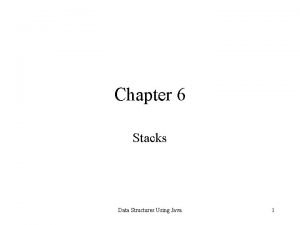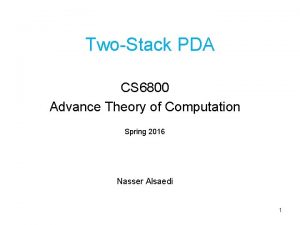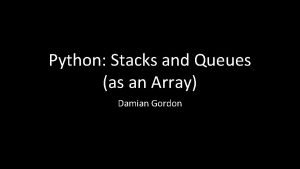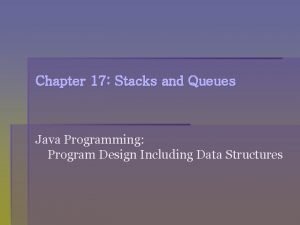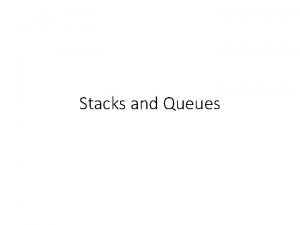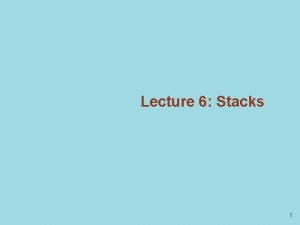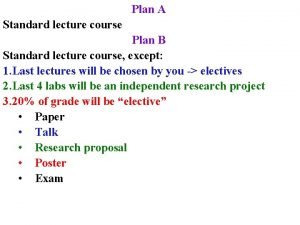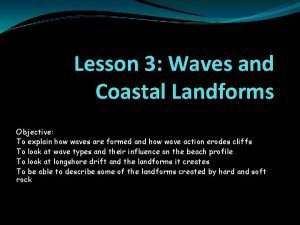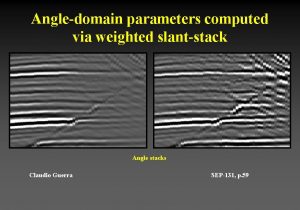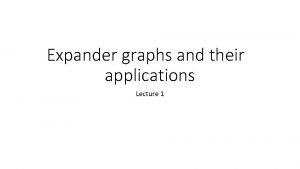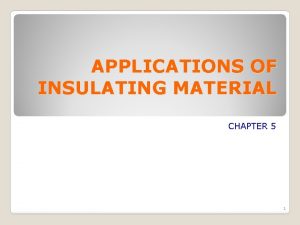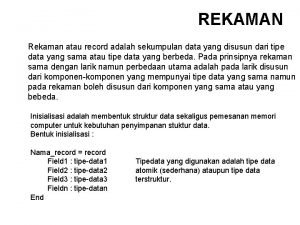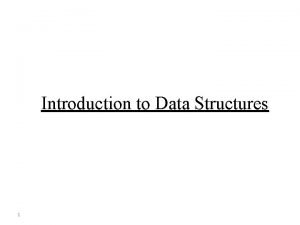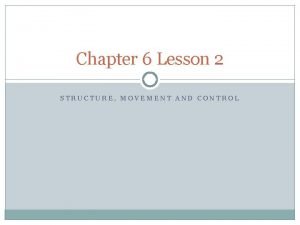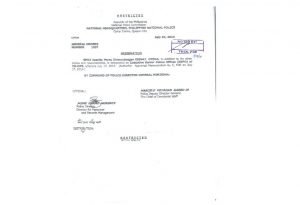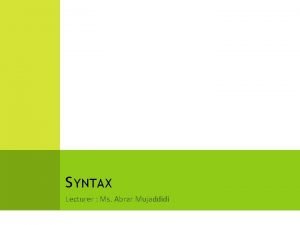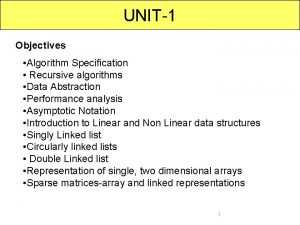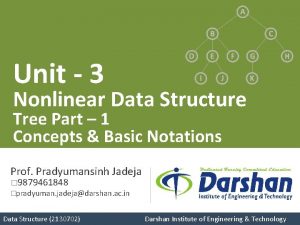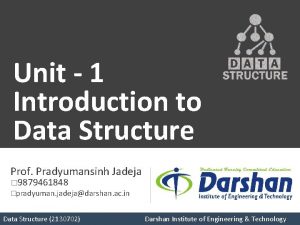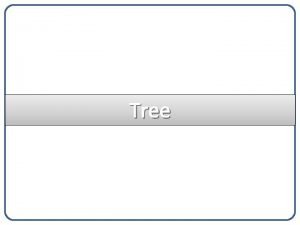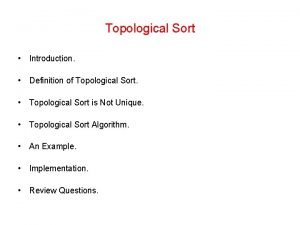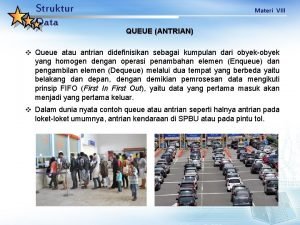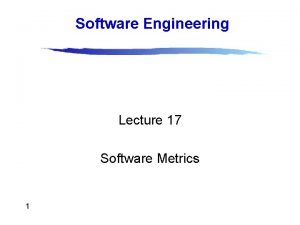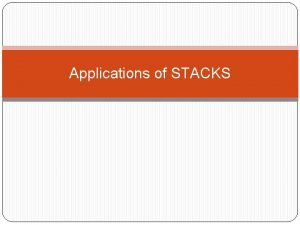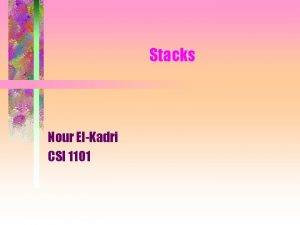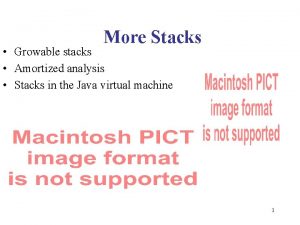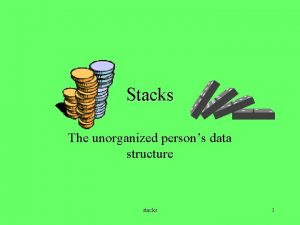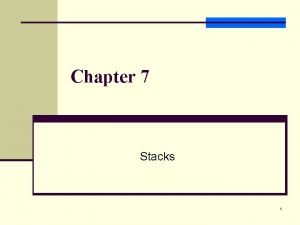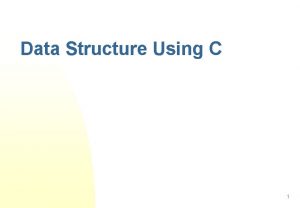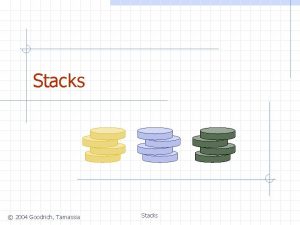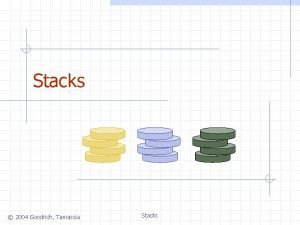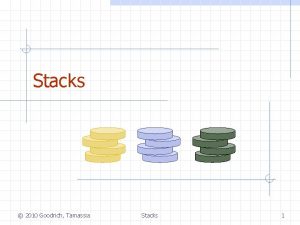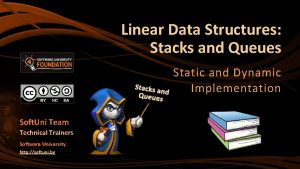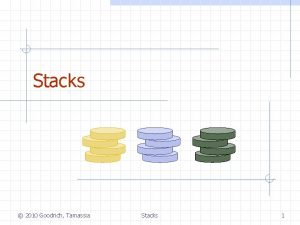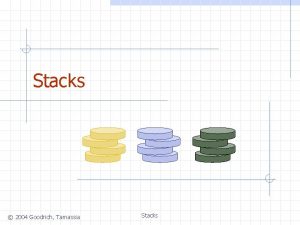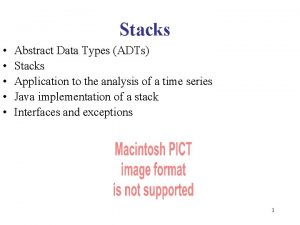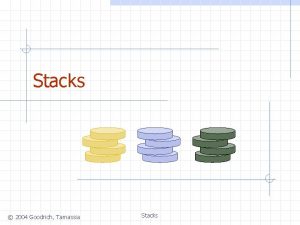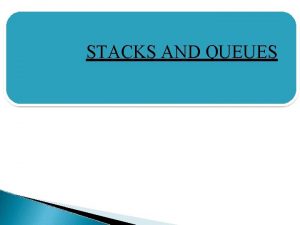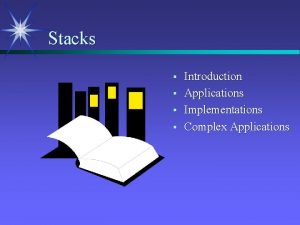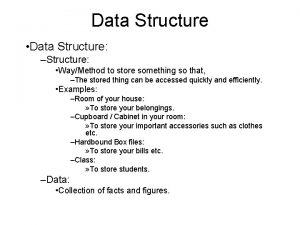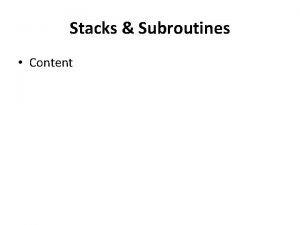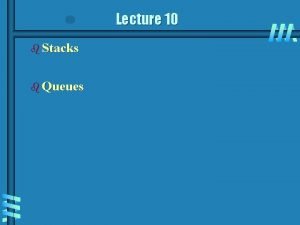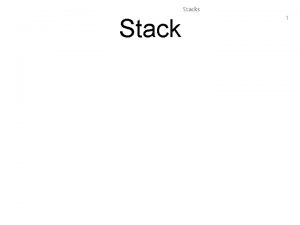Data structure Stacks Their Applications Outline Stacks What
























































- Slides: 56

Data structure Stacks & Their Applications

Outline Stacks What are they and how they work Stack Applications Infix to Postfix conversion Evaluation of Postfix expressions

Stacks – An Overview Abstract Data Type (ADT): What is an Abstract Data Type? To answer this, let us ask the negative of this: What is NOT an Abstract Data Type (in JAVA)? int is a built-in type in the JAVA language double is a built-in type in the JAVA language There are certainly many others we can list These data types are already built into the language.

Stacks – An Overview Abstract Data Type (ADT): So again, what is an Abstract Data Type? It is a data type that is NOT built into the language (well, for our purposes, it isn’t!) It is a data type that we will “build” We will specify what it is, how it is used, etc. It is often defined in terms of its behavior rather than its implemented representation Nice definition from Wikipedia: An abstract data type is defined indirectly, only by the operations that may be performed on it (i. e. behavior) http: //en. wikipedia. org/wiki/Abstract_data_type

Stacks – An Overview Stacks: Stacks are an Abstract Data Type They are NOT built into JAVA We must define them and their behaviors So what is a stack? A data structure that stores information in the form of a stack. Consists of a variable number of homogeneous elements i. e. elements of the same type

Stacks – An Overview Stacks: Access Policy: The access policy for a stack is simple: the first element to be removed from the stack is the last element that was placed onto the stack The main idea is that the last item placed on to the stack is the first item removed from the stack Known as the “Last in, First out” access policy LIFO for short The classical example of a stack is cafeteria trays. New, clean trays are added to the top of the stack. and trays are also taken from the top So the last tray in is the first tray taken out

Stacks – An Overview Stacks: Basic Operations: PUSH: This PUSHes an item on top of the stack POP: This POPs off the top item in the stack and returns it Other important tidbit: The end of the stack, where PUSHes and POPs occur, is usually referred to as the TOP of the stack

Stacks – An Overview PUSH Operation: Element to be inserted into S 6 6 Top 24 24 13 13 7 7 22 22 9 9 Stack S (before push) (after push) Top

Stacks – An Overview POP Operation: Element removed 6 Top 6 6 24 24 13 13 7 7 22 22 9 9 (stack before pop) (stack after pop) Top

Stacks – An Overview Stacks: Other useful operations: is. Empty: Typically implemented as a boolean function Returns TRUE if no items are in the stacck is. Full: Returns TRUE if no more items can be added to the stack In theory, a stack should NEVER become full Actual implementations do have limits on the number of elements a stack can store top: Simply returns the value at the top of the stack without actually popping the stack.

Stacks – An Overview Stacks: Other useful operations: Note: Each of those operations ACCESS the stack But they do NOT modify the stack A PUSH can only be done if the stack isn’t full A POP can only be done on a non-empty stack Implementation of a stack: Can be done using both static and dynamic memory Array or a linked list Implemented as an array, the stack could possibly become full As a linked list, this is MUCH LESS LIKELY to occur page 11 We will cover detailed implementations NEXT TIME. © Dr. Jonathan (Yahya) Cazalas Stacks & Their Applications

Using Stacks So when is stack useful? When data needs to be stored and then retrieved in reverse order There are several examples/applications outside the scope of this class For now, we go over two classical examples… page 12 Be patient and they will come up This examples help facilitate learning about stacks and their operations. © Dr. Jonathan (Yahya) Cazalas Stacks & Their Applications

Stack Application(s) Evaluating Arithmetic Expressions Consider the expression 5 * 3 + 2 + 6 * 4 How do we evaluate this? page 13 DUH No, but seriously, think about what happens during the evaluation We multiply 5 and 3 to get 15, and then we add 2 to that result to get 17. Then we store that off in our head somewhere. We then multiply 6 and 4 to get 24 Lastly, we then retrieve the stored value (17) and add it to 24 to get the result… 41. © Dr. Jonathan (Yahya) Cazalas Stacks & Their Applications

Stack Application(s) Evaluating Arithmetic Expressions Consider the expression 5 * 3 + 2 + 6 * 4 That was only easy cuz we knowza some math and rules of precedence, etc. What if you didn’t know those rules? Well, there’s an easy way of writing out this sequence of events. It does seem weird at first glance…but it works! 5 3 * 2 + 6 4 * + page 14 you read this left to right the operators are ALWAYS in the correct evaluation order This notation ©is. Dr. called postfix notation. Jonathan (Yahya) Cazalas Stacks & Their Applications

Stack Application(s) Basically, there are 3 types of notations for expressions Infix: operator is between operands Postfix: operator follows operands page 15 A B + Prefix: operator comes before operands A + B + A B Again, in a postfix expression, operators are ALWAYS in correct evaluation order. © Dr. Jonathan (Yahya) Cazalas Stacks & Their Applications

Stack Application(s) Evaluation of infix expressions has 2 basic steps: Convert infix expression to a postfix expression. Evaluate the newly converted postfix expression. And guess what… Stacks are useful in both of these steps Let’s start with seeing how to actually evaluate that crazy looking expression page 16 © Dr. Jonathan (Yahya) Cazalas Stacks & Their Applications

Stack Application(s) Evaluating a Postfix Expression (A B +) Of course, we use a stack Each operator in a postfix expression refers to the previous two operands When you read an operand PUSH it onto the stack When you read an operator, it’s associated operands are POPed off the stack The indicated operation (based on the operand) is performed on the two operators Result is PUSHed back onto the stack so it can be available for use as an operand for the next operator. Process stops when there are no more operators in expression Final result is obtained by popping off remaining value in stack. page 17 © Dr. Jonathan (Yahya) Cazalas Stacks & Their Applications

Stack Application(s) Evaluating a Postfix Expression Consider the simple expression: 5 * 3 + 2 + 6 * 4 As mentioned, this converts to the following postfix expression: 5 3 * 2 + 6 4 * + page 18 So follow the rules and evaluate this! © Dr. Jonathan (Yahya) Cazalas Stacks & Their Applications

5 3 * 2 + 6 4 * + Step 1: We have an operand, 5. What do we do? The rule stated: When you encounter an operand, PUSH it onto the stack. So we PUSH 5 onto the stack. 5 page 19 © Dr. Jonathan (Yahya) Cazalas Stacks & Their Applications

5 3 * 2 + 6 4 * + Step 2: PUSH 3 on the stack 3 5 page 20 © Dr. Jonathan (Yahya) Cazalas Stacks & Their Applications

5 3 * 2 + 6 4 * + Step 3: We have an operator! What do we do? page 21 1. POP the top two operands off the stack. 1. So POP 3 and 5. 2. Perform the indicated operation. 2. 5*3 = 15 3. PUSH the result back onto the stack. 3. PUSH 15 back on the stack 3 5 © Dr. Jonathan (Yahya) Cazalas Stacks & Their Applications

5 3 * 2 + 6 4 * + Step 3: We have an operator! What do we do? page 22 1. POP the top two operands off the stack. 1. So POP 3 and 5. 2. Perform the indicated operation. 2. 5*3 = 15 3. PUSH the result back onto the stack. 3. PUSH 15 back on the stack 15 © Dr. Jonathan (Yahya) Cazalas Stacks & Their Applications

5 3 * 2 + 6 4 * + Step 4: PUSH 2 on the stack 2 15 page 23 © Dr. Jonathan (Yahya) Cazalas Stacks & Their Applications

5 3 * 2 + 6 4 * + Step 5: We have an operator! What do we do? 1. POP the top two operands off the stack. 1. So POP 2 and 15. 2. Perform the indicated operation. 2. 15 + 2 = 17 3. PUSH the result back onto the stack. page 24 2 3. PUSH 17 back on the stack 15 © Dr. Jonathan (Yahya) Cazalas Stacks & Their Applications

5 3 * 2 + 6 4 * + Step 5: We have an operator! What do we do? page 25 1. POP the top two operands off the stack. 1. So POP 2 and 15. 2. Perform the indicated operation. 2. 15 + 2 = 17 3. PUSH the result back onto the stack. 3. PUSH 17 back on the stack 17 © Dr. Jonathan (Yahya) Cazalas Stacks & Their Applications

5 3 * 2 + 6 4 * + Step 6: PUSH 6 on the stack 6 17 page 26 © Dr. Jonathan (Yahya) Cazalas Stacks & Their Applications

5 3 * 2 + 6 4 * + Step 7: PUSH 4 on the stack 4 6 17 page 27 © Dr. Jonathan (Yahya) Cazalas Stacks & Their Applications

5 3 * 2 + 6 4* + Step 8: We have an operator! What do we do? 1. POP the top two operands off the stack. 1. So POP 4 and 6. 2. Perform the indicated operation. 2. 6 * 4 = 24 3. PUSH the result back onto the stack. page 28 4 6 3. PUSH 24 back on the stack 17 © Dr. Jonathan (Yahya) Cazalas Stacks & Their Applications

5 3 * 2 + 6 4* + Step 8: We have an operator! What do we do? 1. POP the top two operands off the stack. 1. So POP 4 and 6. 2. Perform the indicated operation. 2. 6 * 4 = 24 3. PUSH the result back onto the stack. page 29 24 3. PUSH 24 back on the stack 17 © Dr. Jonathan (Yahya) Cazalas Stacks & Their Applications

5 3 * 2 + 6 4 *+ Step 9: We have an operator! What do we do? 1. POP the top two operands off the stack. 1. So POP 24 and 17. 2. Perform the indicated operation. 2. 17 + 24 = 41 3. PUSH the result back onto the stack. page 30 24 3. PUSH 41 back on the stack 17 © Dr. Jonathan (Yahya) Cazalas Stacks & Their Applications

5 3 * 2 + 6 4 *+ Step 9: We have an operator! What do we do? page 31 1. POP the top two operands off the stack. 1. So POP 24 and 17. 2. Perform the indicated operation. 2. 17 + 24 = 41 3. PUSH the result back onto the stack. 3. PUSH 41 back on the stack 41 © Dr. Jonathan (Yahya) Cazalas Stacks & Their Applications

5 3 * 2 + 6 4 * + Step 10: There are no more operators. So pop the final value off the stack. Result is 41 41 page 32 © Dr. Jonathan (Yahya) Cazalas We’re Done! Stacks & Their Applications

Stack Application(s) Again, there are 2 steps to evaluate infix expressions. 1. Evaluate the postfix expression (once converted) Been there, done that (for those that were sleeping, that was the long previous example) 2. But before we can evaluate, we must first convert the infix exp. to a postfix exp. page 33 Infix: 5 * 3 + 2 + 6 * 4 Postfix: 5 3 * 2 + 6 4 * + How do we do this… © Dr. Jonathan (Yahya) Cazalas Stacks & Their Applications

Stack Application(s) Converting Infix Exp. to Postfix Exp. Again, we use a stack But now, this is strictly an “operator only” stack Only the operators are stored on the stack Upon reading an operand, the operand is immediately placed into output list (printed out straight away). There are several rules on how this stack should be used But with an example, it should be easy to understand page 34 © Dr. Jonathan (Yahya) Cazalas Stacks & Their Applications

Stack Application(s) Converting Infix Exp. to Postfix Exp. Rules 1. 2. 3. 4. 5. 6. 7. 8. 9. 10. page 35 Assume the operation is a legal one (meaning, it is possible to evaluate it). Upon reading an operand, it is immediately placed into the output list (printed straight away). Only the operators are placed in the stack. To start, the stack is empty. The infix expression is read left to right. The first operator read is pushed directly onto the stack. For all subsequent operators, the priority of the “incoming-operator” (the one being read) will be compared with the operator on the top of the stack. If the priority of the incoming-operator is higher than the priority of the operator on the top of the stack, then the incoming-operator will be simply PUSHed on the stack. If the priority of the incoming-operator is same or lower than the priority of the operator at the top of the stack, then the operator at top of the stack will be POPed and printed on the output expression. The process is repeated if the priority of the incoming-operator is still same or lower than the next operator-in-the stack. When a left parenthesis is encountered in the expression it is immediately pushed on the stack, as it has the highest priority. However, once it is inside the stack, all other operators are pushed on top of it, as its inside-stack priority is lowest. When a right parenthesis is encountered, all operators up to the left parenthesis are popped from the stack and printed out. The left and right parentheses will be discarded. When all characters from the input infix expression have been read, the operators remaining inside the stack, are printed out in the order in which they are popped. © Dr. Jonathan (Yahya) Cazalas Stacks & Their Applications

Stack Application(s) Converting Infix Exp. to Postfix Exp. Rules One more thing, before we begin, we must know the order of precedence for the operators The priority is as follows, with the first being the top priority (highest precedence) 1. 2. 3. 4. page 36 ( * + ( Left parenthesis inside the expression / Left parenthesis inside the stack The left parenthesis has the highest priority when it is read from the expression, but once it is on the stack, it assumes the lowest priority. © Dr. Jonathan (Yahya) Cazalas Stacks & Their Applications

5 * 3 + 2 + 6 * 4 Step 1: 5 is an operand. It is placed directly onto output list. Resulting Postfix Expression: page 37 5 © Dr. Jonathan (Yahya) Cazalas Stacks & Their Applications

5 * 3 + 2 + 6 * 4 Step 2: * is an operator. The stack is empty; so PUSH * into the stack. * Resulting Postfix Expression: page 38 5 © Dr. Jonathan (Yahya) Cazalas Stacks & Their Applications

5 * 3 + 2 + 6 * 4 Step 3: 3 is an operand. It is placed directly onto output list. * Resulting Postfix Expression: page 39 53 © Dr. Jonathan (Yahya) Cazalas Stacks & Their Applications

5 * 3 + 2 + 6 * 4 Step 4: + is an operator. The stack is not empty; compare precedence of + to *. * Resulting Postfix Expression: page 40 53 © Dr. Jonathan (Yahya) Cazalas Stacks & Their Applications

Stack Application(s) Converting Infix Exp. to Postfix Exp. Rules One more thing, before we begin, we must know the order of precedence for the operators The priority is as follows, with the first being the top priority (highest precedence) 1. ( Left parenthesis inside the expression 2. * / 3. + 4. ( Left parenthesis inside the stack page 41 The left parenthesis has the highest priority when it is read from the expression, but once it is on the stack, it assumes the lowest priority. © Dr. Jonathan (Yahya) Cazalas Stacks & Their Applications

Stack Application(s) Converting Infix Exp. to Postfix Exp. Rules 1. 2. 3. 4. 5. 6. 7. 8. 9. 10. page 42 Assume the operation is a legal one (meaning, it is possible to evaluate it). Upon reading an operand, it is immediately placed into the output list (printed straight away). Only the operators are placed in the stack. To start, the stack is empty. The infix expression is read left to right. The first operator read is pushed directly onto the stack. For all subsequent operators, the priority of the “incoming-operator” (the one being read) will be compared with the operator on the top of the stack. If the priority of the incoming-operator is higher than the priority of the operator on the top of the stack, then the incoming-operator will be simply PUSHed on the stack. If the priority of the incoming-operator is same or lower than the priority of the operator at the top of the stack, then the operator at top of the stack will be POPed and printed on the output expression. The process is repeated if the priority of the incoming-operator is still same or lower than the next operator-in-the stack. When a left parenthesis is encountered in the expression it is immediately pushed on the stack, as it has the highest priority. However, once it is inside the stack, all other operators are pushed on top of it, as its inside-stack priority is lowest. When a right parenthesis is encountered, all operators up to the left parenthesis are popped from the stack and printed out. The left and right parentheses will be discarded. When all characters from the input infix expression have been read, the operators remaining inside the stack, are printed out in the order in which they are popped. © Dr. Jonathan (Yahya) Cazalas Stacks & Their Applications

5 * 3 + 2 + 6 * 4 Step 4: + is an operator. The stack is not empty; compare precedence of + to *. + than *. is So PUSH stack. we lower priority POP + * onto and the +* Resulting Postfix Expression: page 43 53* © Dr. Jonathan (Yahya) Cazalas Stacks & Their Applications

5 * 3 + 2 + 6 * 4 Step 5: 2 is an operand. It is placed directly onto output list. + Resulting Postfix Expression: page 44 5 3 * © Dr. Jonathan (Yahya) Cazalas 2 Stacks & Their Applications

5 * 3 + 2 + 6 * 4 Step 6: + is an operator. The stack is not empty; compare precedence of + to +. + Resulting Postfix Expression: page 45 5 3 * © Dr. Jonathan (Yahya) Cazalas 2 Stacks & Their Applications

5 * 3 + 2 + 6 * 4 Step 6: + is an operator. The stack is not empty; compare precedence of + to +. + is same priority as +. So we POP + and PUSH + onto the stack. + Resulting Postfix Expression: page 46 5 3 * © Dr. Jonathan (Yahya) Cazalas 2 + Stacks & Their Applications

5 * 3 + 2 + 6 * 4 Step 7: 6 is an operand. It is placed directly onto output list. + Resulting Postfix Expression: page 47 5 3 * © Dr. Jonathan (Yahya) Cazalas 2 + 6 Stacks & Their Applications

5 * 3 + 2 + 6* 4 Step 8: * is an operator. The stack is not empty; compare precedence of * to +. + Resulting Postfix Expression: page 48 5 3 * © Dr. Jonathan (Yahya) Cazalas 2 + 6 Stacks & Their Applications

Stack Application(s) Converting Infix Exp. to Postfix Exp. Rules One more thing, before we begin, we must know the order of precedence for the operators The priority is as follows, with the first being the top priority (highest precedence) 1. 2. 3. 4. page 49 ( * + ( Left parenthesis inside the expression / Left parenthesis inside the stack The left parenthesis has the highest priority when it is read from the expression, but once it is on the stack, it assumes the lowest priority. © Dr. Jonathan (Yahya) Cazalas Stacks & Their Applications

Stack Application(s) Converting Infix Exp. to Postfix Exp. Rules 1. 2. 3. 4. 5. 6. 7. 8. 9. 10. page 50 Assume the operation is a legal one (meaning, it is possible to evaluate it). Upon reading an operand, it is immediately placed into the output list (printed straight away). Only the operators are placed in the stack. To start, the stack is empty. The infix expression is read left to right. The first operator read is pushed directly onto the stack. For all subsequent operators, the priority of the “incoming-operator” (the one being read) will be compared with the operator on the top of the stack. If the priority of the incoming-operator is higher than the priority of the operator on the top of the stack, then the incoming-operator will be simply PUSHed on the stack. If the priority of the incoming-operator is same or lower than the priority of the operator at the top of the stack, then the operator at top of the stack will be POPed and printed on the output expression. The process is repeated if the priority of the incoming-operator is still same or lower than the next operator-in-the stack. When a left parenthesis is encountered in the expression it is immediately pushed on the stack, as it has the highest priority. However, once it is inside the stack, all other operators are pushed on top of it, as its inside-stack priority is lowest. When a right parenthesis is encountered, all operators up to the left parenthesis are popped from the stack and printed out. The left and right parentheses will be discarded. When all characters from the input infix expression have been read, the operators remaining inside the stack, are printed out in the order in which they are popped. © Dr. Jonathan (Yahya) Cazalas Stacks & Their Applications

5 * 3 + 2 + 6* 4 Step 8: * is an operator. The stack is not empty; compare precedence of * to +. * is a higher priority than +. So we simply PUSH * onto the stack. * + Resulting Postfix Expression: page 51 5 3 * © Dr. Jonathan (Yahya) Cazalas 2 + 6 Stacks & Their Applications

5 * 3 + 2 + 6 *4 Step 9: 4 is an operand. It is placed directly onto output list. * + Resulting Postfix Expression: page 52 5 3 * © Dr. Jonathan (Yahya) Cazalas 2 + 6 4 Stacks & Their Applications

5 * 3 + 2 + 6 * 4 Step 10: Infix exp. has been completely read. POP remaining operators that are in the stack. * And now we’re done. We have an equivalent postfix expression. + Resulting Postfix Expression: page 53 5 3 * © Dr. Jonathan (Yahya) Cazalas 2 + 6 4 * + Stacks & Their Applications

Stack Application(s) Two more examples: The contents of the operator stack at the indicated points in the infix expressions (points A, B and C) are shown below for each case page 54 © Dr. Jonathan (Yahya) Cazalas Stacks & Their Applications

Stack Application(s) Last example: The contents of the operator stack at the indicated points in the infix expressions (points A, B and C) are shown below for each case page 55 © Dr. Jonathan (Yahya) Cazalas Stacks & Their Applications

Stack Application(s) You now know how to: 1. Convert an Infix expression to a Postfix expression 2. And then evaluate that resulting expression page 56 © Dr. Jonathan (Yahya) Cazalas Stacks & Their Applications
 Data structures using java
Data structures using java What is static and dynamic data structure
What is static and dynamic data structure Pda advance directive
Pda advance directive Python queue clear
Python queue clear Cliff terrace caves stacks
Cliff terrace caves stacks Java stacks and queues
Java stacks and queues Types of stacks
Types of stacks Exercises on stacks and queues
Exercises on stacks and queues Java stacks and queues
Java stacks and queues Stacks+routined
Stacks+routined 6 stacks
6 stacks Speed stacks spreads nationally in 1998.
Speed stacks spreads nationally in 1998. The individual flattened stacks of membrane
The individual flattened stacks of membrane Stacks internet
Stacks internet Bays and headlands
Bays and headlands Angle stacks
Angle stacks How to make a sandwich paragraph
How to make a sandwich paragraph N-ary relations
N-ary relations Expander graphs and their applications
Expander graphs and their applications Solid insulating materials and their applications
Solid insulating materials and their applications Two households both alike in dignity
Two households both alike in dignity Rekaman data adalah
Rekaman data adalah What is elementary data organization in data structure
What is elementary data organization in data structure Sap systems applications and products
Sap systems applications and products System application and products in data processing
System application and products in data processing Spatial data mining applications
Spatial data mining applications Building data mining applications for crm
Building data mining applications for crm Characteristics of big data applications
Characteristics of big data applications Data driven web applications
Data driven web applications Novel data science applications
Novel data science applications Lesson outline structure movement and control
Lesson outline structure movement and control Paragraph layout
Paragraph layout Social statuses
Social statuses Unorganized points and outline structure
Unorganized points and outline structure Outline data
Outline data Organizational chart pnp
Organizational chart pnp What is the function of the seed of a plant
What is the function of the seed of a plant Group of people
Group of people Statuses and their related roles determine the structure
Statuses and their related roles determine the structure Giant molecular structure vs simple molecular structure
Giant molecular structure vs simple molecular structure N++++
N++++ Giant molecular structure vs simple molecular structure
Giant molecular structure vs simple molecular structure Structural ambiguity examples
Structural ambiguity examples Surface structure
Surface structure Np aux vp
Np aux vp Giant molecular structure vs simple molecular structure
Giant molecular structure vs simple molecular structure Deep and surface structure in linguistics
Deep and surface structure in linguistics Linear data structure
Linear data structure Sequential organization in data structure
Sequential organization in data structure Linear and nonlinear data structure
Linear and nonlinear data structure Data structure primitive and non primitive
Data structure primitive and non primitive Linear and nonlinear data structure
Linear and nonlinear data structure Bfs tree traversal
Bfs tree traversal Graph topological sort
Graph topological sort Threaded trees
Threaded trees Types of queue in data structure
Types of queue in data structure Data structure metrics in software engineering
Data structure metrics in software engineering
